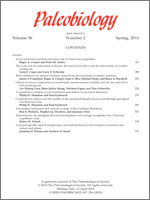The most abundant and diverse graptolite assemblages are found in offshore, deep-water black shales—the classical “graptolite facies” (deep-water or isograptid biofacies). The mean duration of Ordovician graptolite species confined to the deep-water facies (here referred to as “group 1” species) is 2.19 Myr, significantly shorter than the mean duration of species in the deep-water facies that are also known in sediments of the shallow-water shelf or platform (“group 2” species) −4.42 Myr, indicating a significantly higher extinction probability (p = <0.001). These figures are based on the precise age ranges of species derived from the time-calibrated composite sequence of 1446 Ordovician to early Devonian graptolites, built by the constrained optimization procedure (CONOP) from 256 measured sections worldwide, and exclude the effects of the Hirnantian mass extinction. The difference between groups cuts across families, morphological types, and pandemic/endemic distributions. An environmental influence is strongly suggested, and although both groups were planktonic, they were unlikely to have shared the same habitat in the water column. The new duration measurements therefore are interpreted as favoring a depth-stratification of graptolite habitats in the water column.
BioOne.org will be down briefly for maintenance on 17 December 2024 between 18:00-22:00 Pacific Time US. We apologize for any inconvenience.
How to translate text using browser tools
1 March 2010
Facies preference predicts extinction risk in Ordovician graptolites
Roger A. Cooper,
Peter M. Sadler
ACCESS THE FULL ARTICLE

Paleobiology
Vol. 36 • No. 2
March 2010
Vol. 36 • No. 2
March 2010




